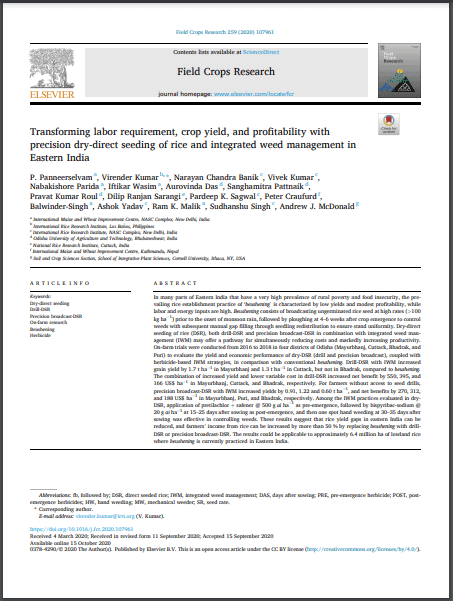In many parts of Eastern India that have a very high prevalence of rural poverty and food insecurity, the prevailing rice establishment practice of ‘beushening’ is characterized by low yields and modest profitability, while labor and energy inputs are high. Beushening consists of broadcasting ungerminated rice seed at high rates (>100 kg ha−1) prior to the onset of monsoon rain, followed by ploughing at 4–6 weeks after crop emergence to control weeds with subsequent manual gap filling through seedling redistribution to ensure stand uniformity. Dry-direct seeding of rice (DSR), both drill-DSR and precision broadcast-DSR in combination with integrated weed management (IWM) may offer a pathway for simultaneously reducing costs and markedly increasing productivity. On-farm trials were conducted from 2016 to 2018 in four districts of Odisha (Mayurbhanj, Cuttack, Bhadrak, and Puri) to evaluate the yield and economic performance of dry-DSR (drill and precision broadcast), coupled with herbicide-based IWM strategies, in comparison with conventional beushening. Drill-DSR with IWM increased grain yield by 1.7 t ha−1 in Mayurbhanj and 1.3 t ha−1 in Cuttack, but not in Bhadrak, compared to beushening. The combination of increased yield and lower variable cost in drill-DSR increased net benefit by 550, 395, and 166 US$ ha−1 in Mayurbhanj, Cuttack, and Bhadrak, respectively. For farmers without access to seed drills, precision broadcast-DSR with IWM increased yields by 0.91, 1.22 and 0.60 t ha−1, and net benefits by 270, 312, and 188 US$ ha−1 in Mayurbhanj, Puri, and Bhadrak, respectively. Among the IWM practices evaluated in dry-DSR, application of pretilachlor + safener @ 500 g ai ha−1 as pre-emergence, followed by bispyribac-sodium @ 20 g ai ha−1 at 15–25 days after sowing as post-emergence, and then one spot hand weeding at 30–35 days after sowing was effective in controlling weeds. These results suggest that rice yield gaps in eastern India can be reduced, and farmers’ income from rice can be increased by more than 50 % by replacing beushening with drill-DSR or precision broadcast-DSR. The results could be applicable to approximately 6.4 million ha of lowland rice where beushening is currently practiced in Eastern India.

